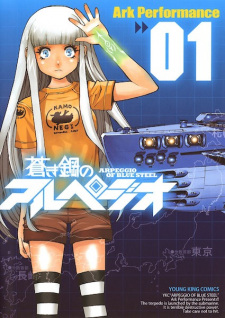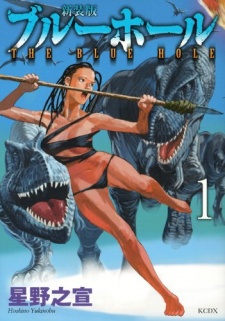May 6, 2013
One day, out of nowhere, a race of sentient, hyper-advanced battleships called the Fleet of Fog appear across the earth and blockade the entire human race onto land. The humans fight back and, despite being massively behind technologically to the battleships, they do far better than expected and capture one of the ships. The Fleet of Fog reason that this is because the humans used strategy and tactics, while the Fleet of Fog have no concept of time so cannot learn from the past or predict the future. How they come to this conclusion in the first place when they supposedly can’t learn isn’t explained,
...
probably because it’s a glaring plothole, but anyway. The Fleet of Fog decide to create their own humans to command each of their own battleships so they can-
Look, basically it’s moe anthropomorphised battleships.
For a concept created simply so the mangaka had an excuse to draw both cute girls and giant battleships, Arpeggio of Blue Steel has a remarkable amount of thought put into its world. The politics behind how the world reacted to the appearance of the Fleet of Fog is explored in quite a lot of detail, and the manga focuses on how the politics and alliances work after that. The early volumes are about the politics behind which country the main character has to sail to because they can’t necessarily trust other countries, or even differing political forces within Japan itself. The science going on behind the ship battles in incredibly in-depth. You can tell the author is a massive navy-nerd with the amount of technobabble that goes on.
I just wish I knew what was going on in those battles sometimes. There will be these massive two-page spreads of a battleship firing its supercharged interdimensional laser, with the ocean splitting like they’ve got Moses on board and giant explosions and waves crashing into the sides of the ships. It’s pretty impressive to look at, but there’s so much detail I can barely tell one ship for another. For the first battle in the manga, I genuinely didn’t realise until after that there was apparently 3 ships taking part rather than just 2. I admit this my own fault as I’m terrible at reading manga and can never tell what’s going on in action scenes.
I’m not going to take the blame for struggling with the tactics though. The technobabble is not just there for its own sake. All the terms they throw out actually mean something. You need a bloody glossary to keep up with the battles, which the manga does helpfully provide. Remembering them all is difficult since fuzzy science like nanomachines and interdimensional lasers are mixed in with sonars and torpedos and resonance and actual real science, but you still need to know your acoustic torpedoes from your corrosive torpedoes. There is a lot of thought put in though, so I do kinda like digging into the broader concepts of their weird science fiction, even if I am rather confused by the fact they still use sonar when they can literally part the sea.
The world building and politics are a little easier to follow, and since the science usually ends up tying into the world, the two sides complement each other quite well. The actual main story is a bit of a let-down in comparison. It’s about this gang of college graduates who have taken command of the one Fleet of Fog battleship humanity have commandeered and how they play into the much larger role of the world politics. It could be interesting certainly, but again the author has trouble conveying all that information in an understandable fashion. The manga starts halfway through the story for whatever bizarre reason. They already have the ship, one of their crew members have left, and all sorts of other things have happened by the time the story begins. I really don’t understand why they did this, since it means you have to get used to a boatload (hur hur see whut i did thar) of characters right off the bat while trying to piece together the timeline of events at the same time.
On the character front, I love the main character’s dad because he’s basically Gendo Ikari. I also like that the Prime Minister of Japan is a mute in a wheelchair. However the characterisation can be a bit all over the place, particularly with the battleship girls. The idea with them is they’re supposed to be not used to their human form and start developing emotions but don’t know how to deal with them. The one girl they do this properly with, the one with the massive coat, is probably my favourite character in the series precisely because of how they explore this side of her. On the other hand, a bunch of the other girls appear with their personality already in place, which neither makes a whole lot of sense and can also be super annoying when the girls fall into tired stereotypes.
If I’m feeling cynical, I’m willing to bet the stereotypes evolved out of the author wanting to appeal to popular archetypes for easy popularity growth. As the volumes go on, the less shots you get of massive battleships and the more it focuses on hot girls. Don’t get me wrong, the tsundere heavy cruiser does have a fine ass (now there’s a line I never thought I’d type). But if I want hot girls, I can go pretty much anywhere. However if I want a manga with massive battleships, I go to Arpeggio of Blue Steel (and maybe Zipang).
Despite all my belly-aching, I do quite like Arpeggio of Blue Steel. I wouldn’t have read 6 volumes if I didn’t. But I definitely prefer the ideas to the execution. If they did make an anime of it, there’s a lot of things I think could be improved. They could make the fights easier to follow, the story start at the actual beginning rather than halfway through, cut out some of the less important characters, and while I’m wishing for the improbable I’d also like a dakimakura of the tsundere heavy cruiser please.
Reviewer’s Rating: 7
What did you think of this review?
Nice
 0
0
Love it
 0
0
Funny
 0
0
Confusing
 0
0
Well-written
 0
0
Creative
 0
0Show all
































